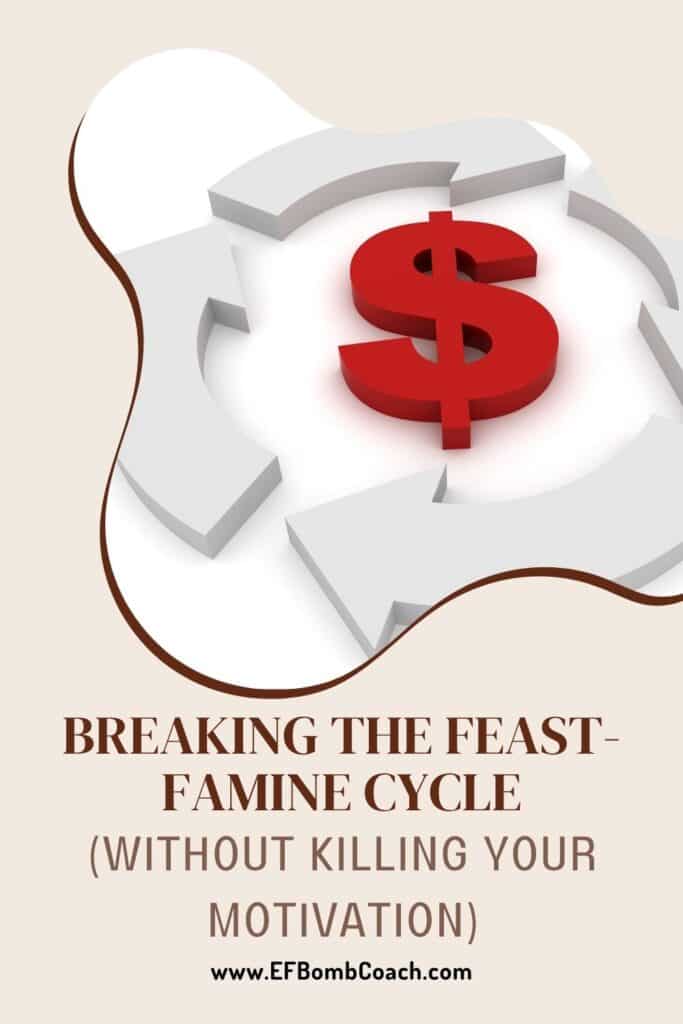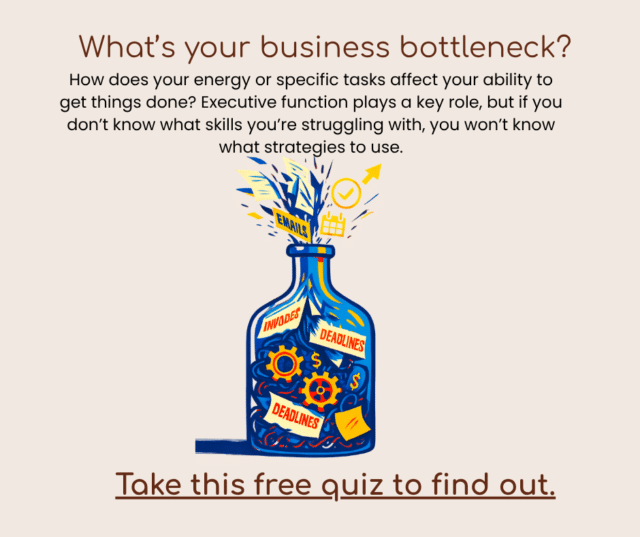Breaking the Feast-Famine Cycle (Without Killing Your Motivation)
Your income zigzags. You sprint when cash gets low, then you coast the second money lands. The dip creeps back in, panic hits, and you sprint again. If this feast-famine cycle sounds familiar, you are not broken. Your brain is chasing urgency, novelty, and quick wins. Stability can feel boring, which breeds delay, which fuels crisis. The fix is not removing the thrill. It is moving it to better places.
In this guide, you'll set a clear income floor, learn a weekly pipeline you can actually stick to, and use planned novelty to keep your brain engaged. You'll also set cash guardrails so slow weeks do not spiral into chaos. By the end, you will have a simple system you can run on repeat.
Understanding the Zigzag Pattern in Your Income
Here is the common pattern. You sprint when money gets low. You coast when you get paid. The cycle repeats, and the swings never stop.
Why it happens: your brain loves urgency, novelty, and quick wins. Stable routines can feel dull, which leads to procrastination. Procrastination leads to panic. Panic flips your focus back on, and you sprint. Rinse and repeat.
If you have ADHD or any other flavor of neurodivergence, this isn't laziness. Your brain often needs urgency to activate. When there's no fire, it can be hard to start. But using financial panic as productivity medication is exhausting, and it keeps you broke.
You can keep the thrill. You just move it into safer, smarter parts of your week.
The Floor, Fuel, Fun Framework: Stop Chaos Without Losing Motivation
You will use three parts, on repeat:
- Floor: Your non-negotiable baseline income. It covers your monthly bills without guessing.
- Fuel: Repeatable pipeline work. The steady actions that bring in clients.
- Fun: Planned novelty. Projects that keep your brain engaged without wrecking cash flow.
You'll repeat this weekly, track your numbers, and make small tweaks. It works because it gives your brain structure and stimulation, without tying focus to a bank-balance crisis.
Grab a pen. You'll set your floor now.
Building Your Income Floor: Secure the Basics First
Step 1: Calculate Your Essentials Number
List the bare-minimum costs that keep the lights on, your team paid, and taxes covered. Total that number.
Common essentials:
- Rent or mortgage
- Food and household needs
- Debt payments
- Team costs or contractors
- Software and operations
- Taxes
- Pay yourself
Example: your monthly essentials total is 4,500 dollars.
Write it like this: Monthly Essentials = $4,500.
Having a clear essentials number removes guesswork. It gives you a target that lowers stress and guides your weekly goals.
Step 2: Find Your Weekly Minimum Revenue
Divide your monthly essentials by 4.5. That is your minimum weekly revenue.
Example: $4,500 ÷ 4.5 = $1,000 per week.
Simple math. Big relief.
Step 3: Choose Your Floor Offer
Your floor offer is the easiest thing you can sell again and again. It should be repeatable, clear, and deliverable without reinventing your workflow.
Smart options:
- Retainer: A monthly package with clear deliverables and auto-billing.
- Course: Recorded or cohort-based, sold on a set schedule.
- Package: A defined service with scope and price, like a monthly content bundle or maintenance plan.
Pick one offer you can sell consistently. This is your foundation.
Step 4: Price It Right
Price your floor offer so you can hit the weekly target with two to five clients. Adjust to fit your capacity and offer type.
Here are a few scenarios if your weekly target is 1,000 dollars:
| Scenario | Clients Needed | Price Per Client | Weekly Total |
|---|---|---|---|
| A | 4 | $250 | $1,000 |
| B | 2 | $500 | $1,000 |
| C | 1 | $1,000 | $1,000 |
Run the math for your business. Use the mix that fits your energy and delivery speed.
Step 5: Set a Capacity Cap
Set a hard limit for how many floor clients you will take. Maybe it's 5. Maybe it's 10. The point is to prevent overload and keep space for higher-margin work and one fun project each month.
Respect your capacity cap. If floor work takes over, you'll avoid it, then cash dips, and the cycle returns.

The 3-R Offer Stack: Create Steady Revenue Streams
Your floor is the start. Now add stability with three repeatable streams:
- Retainers: Monthly deliverables, auto-billed. You don't need to resell each month.
- Recurring products: Subscriptions, templates, memberships, or maintenance plans. People pay regularly, and you avoid custom scope creep.
- Repeatable projects: Scoped, fast-turn packages like VIP days, sprints, or website refreshes. You have done them dozens of times, so they are smooth to deliver.
Keep one planned fun project per month. It can be a creative experiment or a weird one-off that lights you up. Everything else feeds the floor.
Mastering Fuel: The Pipeline Work That Keeps Clients Coming
Pipeline work can feel boring. That's normal. Make it simple enough that you can do it even on low-motivation days.
The 5-3-1 Rule for Daily Actions
Run this quick list every workday:
- 5 new touches: New people to reach out to. Cold DMs, comments on posts, intro emails.
- 3 warm follow-ups: People you have already spoken to. Check on a proposal, ask if they have questions.
- 1 clear ask: Ask for business, a referral, or a meeting.
Do this in two short blocks. Try 25 minutes in the morning, 25 in the afternoon. That's 50 minutes for nine touches. If motivation is low, cut it to 10 minutes and do just the ask. Minimum beats zero.
Tools to Make It Easy
Keep your system low friction:
- Use a basic CRM or a simple Google Sheet with name, stage, next step, and date. It takes two minutes to update.
- Use templates for outreach, follow-ups, and proposals. Templates reduce decisions and save brain energy when you are drained.
- Track sent proposals and close dates in the same sheet so you know when to follow up.
Weekly Rhythm to Fight Boredom
Rotate focus by day. It gives your brain variety without chaos.
| Day | Focus | Actions |
|---|---|---|
| Monday | Pipeline | Review leads, send asks, update CRM. Build momentum early. |
| Tuesday | Client deep work | 90 minutes focused delivery. No inbox, no Slack, no phone. |
| Wednesday | Nurture | Post one helpful thing, DM two people, build relationships. |
| Thursday | Delivery and invoices | Finish client work, send invoices, chase late payments with a script. |
| Friday | Money check-in | Track revenue, proposals sent, cash on hand. Decide next week’s mode. |
Adjust the rhythm to fit your workload, but keep the variety. Do not pile every type of work into every day.

Handling Red Flags: Sprint Mode and Check-Ins
Friday Money Check-In
End each week with a quick review:
- Revenue: $_____
- Proposals sent: _____
- Cash on hand: $_____
If your numbers are green, keep your weekly rhythm. If they're red, switch to sprint mode next week.
Running a Controlled Sprint
A sprint is not panic. It's a planned, time-limited push.
Try a 7-day campaign:
- One clear offer and one deadline.
- Daily touch points with your audience.
- 60 minutes of outreach each day.
- One live piece of content each day.
- One email to your list each day.
- One focused DM block each day.
Structure it in three parts:
- Prep day (day zero): Script your asks. Draft emails and DMs. Create graphics or simple videos. Set everything up so the week is pure execution.
- Execute: Follow the plan. Keep the message consistent. Show up daily.
- Reset: Take one full day to rest and handle admin. Recap what worked, what did not, and what to tweak. Update your pipeline.
Treat it as a controlled sprint, not a last-minute scramble.

Did you know I have a membership for women who want to improve their executive function skills? Check it out here.
Keeping Your Brain Engaged: Boredom-Proof Strategies
Quick Wins for Dull Tasks
Use small boosts that make boring work tolerable:
- Temptation bundling: Only let yourself have the fancy coffee during pipeline time. Or watch a favorite show while doing admin.
- Beat the timer: Turn it into a game. Can you send five follow-ups in 10 minutes?
- Rotate every 25 minutes: Move from admin, to creative, to outreach. Choose the block length that fits you. Ten to thirty minutes works well.
Environment and Novelty Cues
Set cues that flip your focus on:
- Focus playlist that you only play during pipeline.
- Phone in another room so you do not doom-scroll.
- Browser blockers during deep work windows.
- Desk setup cue like a specific lamp or notebook that signals work time.
Use novelty tokens: Allow one planned experiment each week. Try a new marketing platform, test a small offer, or change your content format. Keep it contained. One experiment at a time keeps boredom down and prevents chaos.
Do not grind on the same task for hours. Your brain will check out. Rotate, then return.
Cash Flow Guardrails: Prevent Panic Before It Hits
Set up these rails once. They'll save you when things slow down.
- Separate accounts: Use separate bank accounts for income, taxes, paying yourself, and operations. Automate transfers every Friday. When everything sits in one pot, you cannot tell what is safe to spend.
- Payment terms: Use clear terms like 50 percent upfront and net 7 or net 14. List late fees in your contracts and invoices. Put retainers on autopay with a subscription link or recurring invoice.
- Six-week cushion: Skim 10 percent off each payment into a buffer account. When a slow month hits, you have breathing room and do not slide into panic mode.
- Panic plan: Write three actions you will take when cash dips. For example: a referral push to past clients, a 7-day sprint offer, and a follow-up blitz on open proposals. Having the plan prevents freeze when the numbers look scary.
Put It All Together
Here is the simple path you can run every week:
- Build your Floor with a clear essentials number, a repeatable floor offer, smart pricing, and a capacity cap.
- Feed it with Fuel using the 5-3-1 rule, a low-friction CRM, templates, and a rotating weekly rhythm.
- Keep your brain engaged with Fun through one planned experiment, temptation bundling, timers, and cues.
- Protect it all with cash guardrails, payment terms, autopay, a cushion, and a written panic plan.
You don't have to choose between chaos and consistency. You can keep the excitement, just move it from “will I make rent” to “what new thing will I try this month.” Build the Floor, run the Fuel, add the Fun. Then track your numbers and sprint on purpose when needed. The feast-famine cycle is not your personality, it is a system problem you can fix starting this week.










